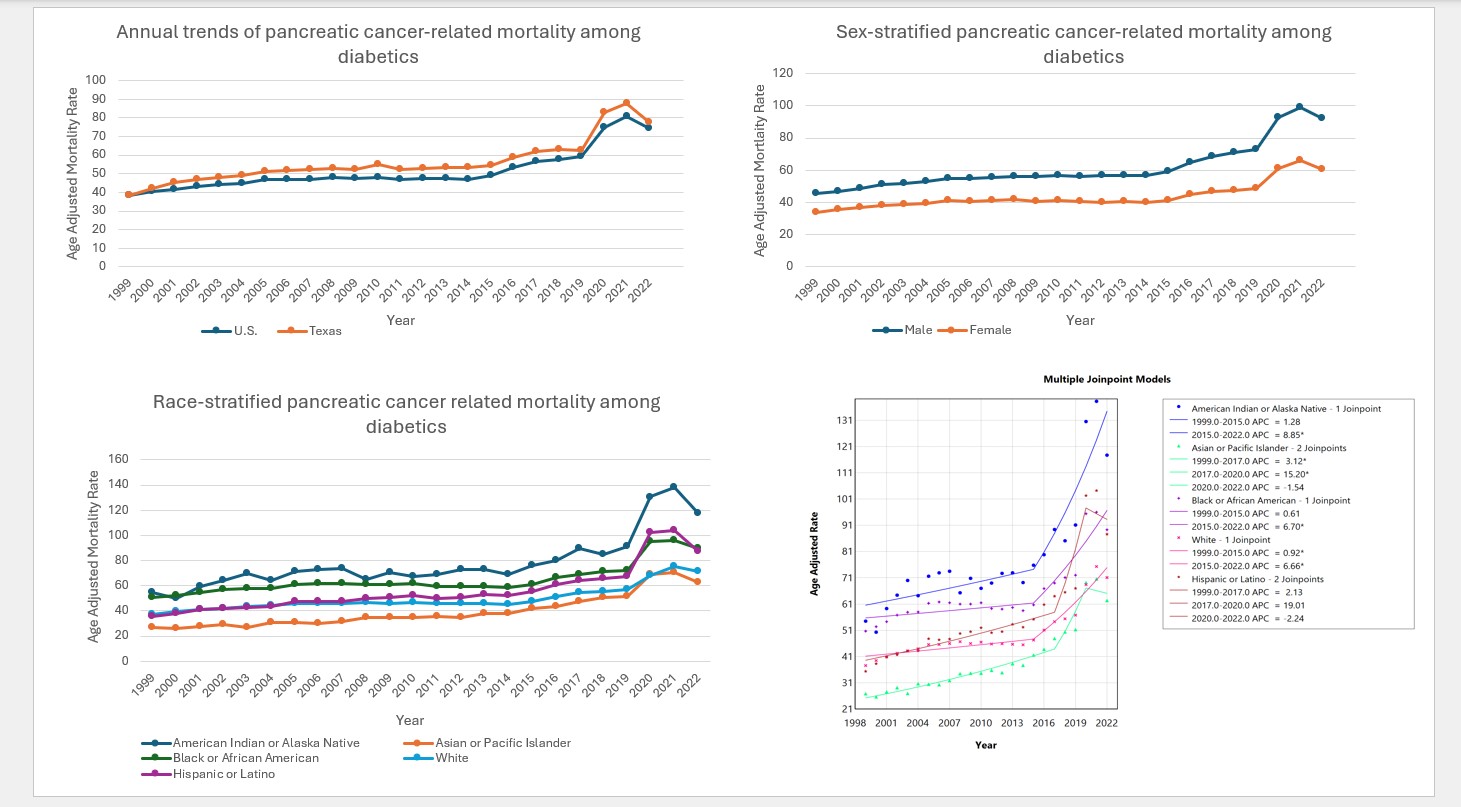Monday Poster Session
Category: Biliary/Pancreas
P2215 - Regional and Racial Disparities in Pancreatic Cancer Mortality Among Adults With Diabetes: A 23-Year Analysis Using CDC WONDER (1999-2022)
Monday, October 27, 2025
10:30 AM - 4:00 PM PDT
Location: Exhibit Hall

Sidra Naz, MD, MPH
University of Texas MD Anderson Cancer Center
Houston, TX
Presenting Author(s)
Sidra Naz, MD, MPH1, Maitri Shah, MD2, Choudhary Ahmed Hasan Maqbool, MD3, Dharshni Ramar, MD3, Shazia Khan, MD4, Adarsh Kumar. Jha, MD2, Rishi Chowdhary, MD5
1University of Texas MD Anderson Cancer Center, Houston, TX; 2University of Michigan Health - Sparrow, Lansing, MI; 3University of Alabama, Heersink School of Medicine, Montgomery regional Campus, Montgomery, AL; 4BronxCare Health System, New York, NY; 5Case Western Reserve University / MetroHealth, Cleveland, OH
Introduction: Diabetes is a significant risk factor for pancreatic cancer, with nearly half of pancreatic cancer patients diagnosed with diabetes. This study aims to estimate the mortality rate of pancreatic cancer (PC) in individuals with type 2 diabetes (T2DM).
Methods: Mortality trends for adults aged ≥ 25 years with T2DM-associated PC were analyzed using CDC WONDER database, identifying deaths through ICD-10 codes C25 “Pancreas Malignant neoplasms” and E11 “T2DM”. Age-adjusted mortality rates per 100,000 were extracted, and annual percent changes with 95% CIs were calculated across demographic (sex, race/ethnicity, age) and geographic (state, urban-rural, regional) subgroups
Results: Between 1999 and 2022, 2807258 documented deaths were attributed to PC among diabetics in the United States. The overall AAMR for T2DM-related PC mortality increased in the US from an adjusted rate (AR) 38.5 in 1999 to 74.4 in 2022 (APC: 2.98%; 95% CI: 2.61% to 3.39%). In Texas, AAMR increased from AR 38.2 in 1999 to 77.5 in 2022 (APC: 2.89%; 95% CI: 2.35% to 3.47%). Males had consistently higher AAMRs than females (92 vs. 60.6). The AAMR in US men increased from 45.3 in 1999 to 92 in 2022 (APC: 3.15%; 95% CI: 2.79% to 3.57%). The AAMR in US women increased from 33.7 in 1999 to 60.6 in 2022 (APC: 2.47%; 95% CI: 2.05% to 2.92%). The non-Hispanic (NH) American Indian or Alaska Native population had the greatest AAMR (117.7), followed by the NH Black or African American (AA) (89.3) and Hispanic or Latino population (87.6). Lower-risk groups were NH White (71.1) and NH Asian or Pacific Islander (62.4). AAMR also varied by region (West: 99.6; Midwest: 78.2; South: 68.6; Northeast: 51.2). Non-metropolitan areas had higher AAMR (small metro: 82.4; non-core areas: 87.9; micropolitan areas: 87.8) than metropolitan areas (large central metropolitan areas: 75.3; large fringe: 62.1). The states in the upper 90th percentile were Oregon, California, Idaho, Wyoming, Oklahoma exhibited an approx. two-fold increase in AAMRs, compared to states falling in the lower 10th percentile Illinois, Louisiana, Georgia, South Carolina, New York
Discussion: Mortality rates from diabetes mellitus type 2-associated pancreas cancer have risen overall in the U.S. over the past two decades. NH American Indian or Alaska Native, NH Black or AA, and Hispanic or Latino men remain at high risk, highlighting the need for further investigation into effective prevention and treatment strategies.

Figure: Annual trends of pancreatic cancer-related mortality among adults with type 2 Diabetes in the United States (1999–2022)
Disclosures:
Sidra Naz indicated no relevant financial relationships.
Maitri Shah indicated no relevant financial relationships.
Choudhary Ahmed Hasan Maqbool indicated no relevant financial relationships.
Dharshni Ramar indicated no relevant financial relationships.
Shazia Khan indicated no relevant financial relationships.
Adarsh Jha indicated no relevant financial relationships.
Rishi Chowdhary indicated no relevant financial relationships.
Sidra Naz, MD, MPH1, Maitri Shah, MD2, Choudhary Ahmed Hasan Maqbool, MD3, Dharshni Ramar, MD3, Shazia Khan, MD4, Adarsh Kumar. Jha, MD2, Rishi Chowdhary, MD5. P2215 - Regional and Racial Disparities in Pancreatic Cancer Mortality Among Adults With Diabetes: A 23-Year Analysis Using CDC WONDER (1999-2022), ACG 2025 Annual Scientific Meeting Abstracts. Phoenix, AZ: American College of Gastroenterology.
1University of Texas MD Anderson Cancer Center, Houston, TX; 2University of Michigan Health - Sparrow, Lansing, MI; 3University of Alabama, Heersink School of Medicine, Montgomery regional Campus, Montgomery, AL; 4BronxCare Health System, New York, NY; 5Case Western Reserve University / MetroHealth, Cleveland, OH
Introduction: Diabetes is a significant risk factor for pancreatic cancer, with nearly half of pancreatic cancer patients diagnosed with diabetes. This study aims to estimate the mortality rate of pancreatic cancer (PC) in individuals with type 2 diabetes (T2DM).
Methods: Mortality trends for adults aged ≥ 25 years with T2DM-associated PC were analyzed using CDC WONDER database, identifying deaths through ICD-10 codes C25 “Pancreas Malignant neoplasms” and E11 “T2DM”. Age-adjusted mortality rates per 100,000 were extracted, and annual percent changes with 95% CIs were calculated across demographic (sex, race/ethnicity, age) and geographic (state, urban-rural, regional) subgroups
Results: Between 1999 and 2022, 2807258 documented deaths were attributed to PC among diabetics in the United States. The overall AAMR for T2DM-related PC mortality increased in the US from an adjusted rate (AR) 38.5 in 1999 to 74.4 in 2022 (APC: 2.98%; 95% CI: 2.61% to 3.39%). In Texas, AAMR increased from AR 38.2 in 1999 to 77.5 in 2022 (APC: 2.89%; 95% CI: 2.35% to 3.47%). Males had consistently higher AAMRs than females (92 vs. 60.6). The AAMR in US men increased from 45.3 in 1999 to 92 in 2022 (APC: 3.15%; 95% CI: 2.79% to 3.57%). The AAMR in US women increased from 33.7 in 1999 to 60.6 in 2022 (APC: 2.47%; 95% CI: 2.05% to 2.92%). The non-Hispanic (NH) American Indian or Alaska Native population had the greatest AAMR (117.7), followed by the NH Black or African American (AA) (89.3) and Hispanic or Latino population (87.6). Lower-risk groups were NH White (71.1) and NH Asian or Pacific Islander (62.4). AAMR also varied by region (West: 99.6; Midwest: 78.2; South: 68.6; Northeast: 51.2). Non-metropolitan areas had higher AAMR (small metro: 82.4; non-core areas: 87.9; micropolitan areas: 87.8) than metropolitan areas (large central metropolitan areas: 75.3; large fringe: 62.1). The states in the upper 90th percentile were Oregon, California, Idaho, Wyoming, Oklahoma exhibited an approx. two-fold increase in AAMRs, compared to states falling in the lower 10th percentile Illinois, Louisiana, Georgia, South Carolina, New York
Discussion: Mortality rates from diabetes mellitus type 2-associated pancreas cancer have risen overall in the U.S. over the past two decades. NH American Indian or Alaska Native, NH Black or AA, and Hispanic or Latino men remain at high risk, highlighting the need for further investigation into effective prevention and treatment strategies.

Figure: Annual trends of pancreatic cancer-related mortality among adults with type 2 Diabetes in the United States (1999–2022)
Disclosures:
Sidra Naz indicated no relevant financial relationships.
Maitri Shah indicated no relevant financial relationships.
Choudhary Ahmed Hasan Maqbool indicated no relevant financial relationships.
Dharshni Ramar indicated no relevant financial relationships.
Shazia Khan indicated no relevant financial relationships.
Adarsh Jha indicated no relevant financial relationships.
Rishi Chowdhary indicated no relevant financial relationships.
Sidra Naz, MD, MPH1, Maitri Shah, MD2, Choudhary Ahmed Hasan Maqbool, MD3, Dharshni Ramar, MD3, Shazia Khan, MD4, Adarsh Kumar. Jha, MD2, Rishi Chowdhary, MD5. P2215 - Regional and Racial Disparities in Pancreatic Cancer Mortality Among Adults With Diabetes: A 23-Year Analysis Using CDC WONDER (1999-2022), ACG 2025 Annual Scientific Meeting Abstracts. Phoenix, AZ: American College of Gastroenterology.
